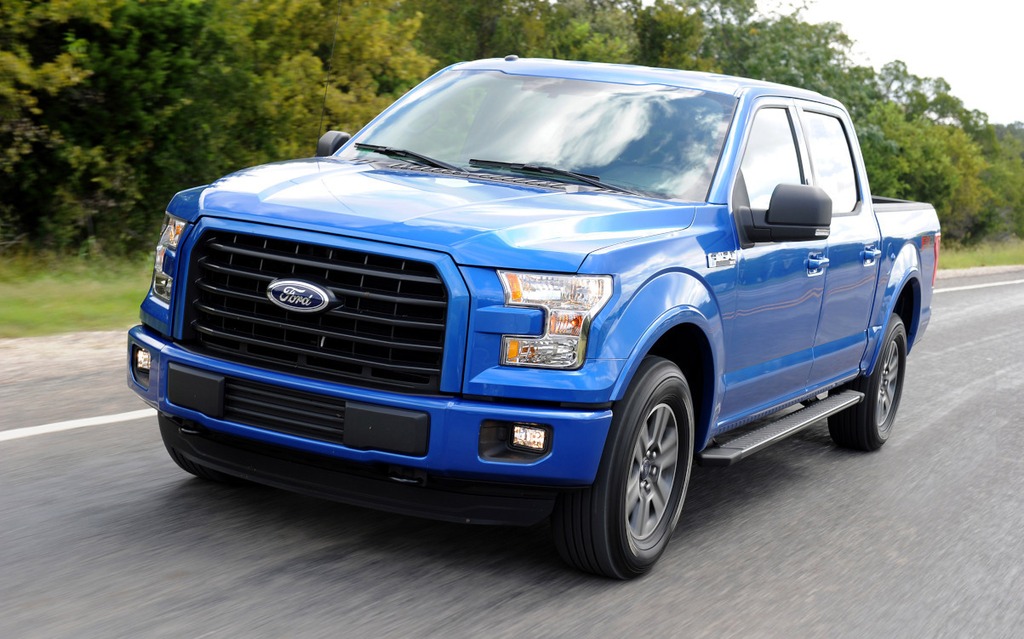2015 Ford F-150 : Aluminum, That Great Unknown
In January 2014, Ford shocked the crowds at the Detroit Motor Show when it unveiled its new 2015 F-150 pickup truck. Not only did this new model boast a modern and elegant silhouette, but its body was made entirely out of aluminum, marking a first in the pickup category. This material has been used for a long time in your everyday products, but generally just for hoods and trunk lids. Until now, the only time we’ve seen auto bodies made entirely out of aluminum has been on a few luxury vehicles.
Reaction in Detroit was mixed. Some people were impressed with Ford’s audacity in swathing its bestselling model in aluminum. Others were skeptical, raising issues like higher production and insurance costs, and more complicated repairs. But the comment that I’ll never forget came from the redneck to my left who said, “Great idea! Ford’s gonna make the F-150 out of old beer cans!"
- Also: 2017 Ford F-150 Raptor: Less Thirst, More Brawn
- Also: Power Output For The 2017 Ford Raptor Unveiled?
No matter how you slice it, Ford has a huge challenge ahead of it. They must be really convinced that this technology is worthwhile if they were even willing to even try. While the jury continues to debate the pros and cons of this move, Ford is doing everything it can to ensure the initiative is a success. And if it is, you can bet that the competition will follow suit—or come out with something just as innovative.
No accident
One thing we all need to keep in mind is that this was not a last-minute decision by Ford. Some of you may recall that in 1993, the automaker developed the Mercury Sable AIV (Aluminum Intensive Vehicle), which featured an all-aluminum body and was powered by the SHO’s V6 engine. Just 20 units were built and none were actually sold. In 2003, we saw the same thing with the Jaguar XJ, which was sold to the public. And last but not least, the Dearborn-based manufacturer also owned Range Rover, another brand that uses aluminum for its auto bodies.
Since Ford kept the Jaguar patents even after it sold the label to Tata, it’s allowed to make this aluminum pickup truck. Ford got the green light for the project in 2009 and development has been speeding along quickly ever since. In order to make the F-150 as solid as possible, the chassis is made from high-strength steel. Then, to verify the robustness of this icon, Ford’s engineers subjected the prototypes to more than 16 million kilometres of tests. In fact, the aluminum F-150 even took part in the legendary Baja 1000 race last year.
Designing this new model is one thing, but producing it in accordance with the original specifications is another thing altogether.
A legendary plant
Of all Ford plants, the River Rouge Complex is the one that will be remembered. The site was purchased in 1915 by Henry Ford, who used it to produce the Model T when World War I ended. This mega-plant is adjacent to the Red River. Boats bring in raw materials and leave with cars fresh off the assembly line. Several popular models have been built there over the years, including the 1964 to 2004 Mustangs. The plant was then revamped and repurposed to produce the F-150 pickup truck. At the time of its inauguration in 2004, it was the most environmentally friendly plant in the United States, with a green roof to offset carbon dioxide emissions and optimize the building’s heating and cooling.
To prepare the factory for making the aluminum F-150, more than 500 new robots were installed and the paint shop was upgraded. This incredible transformation took place over four short weeks last fall. Ford had to work quickly so that inventory wouldn’t be overly depleted. After all, this is the most-sold pickup truck in the world!
Glued and riveted
Building an aluminum body is nothing at all like building a steel one. Three aluminum alloys are needed because different sections have different requirements. For example, the bed is made from thicker, more rigid aluminum. The only steel parts in the body are the firewall (for its insulating qualities) and the door hinges. You may also be interested to know that there are very few weld points, as welding aluminum requires argon, which makes the matter much more complicated than traditional welding. Instead, almost all cabin and body parts are glued and riveted. If you’re wondering how solid this technique is, rest assured that it has been used on aircraft for decades. Last but not least, painting the body is also a whole new process. It calls for a different type of primer and a dust-detection system to enhance the quality of the paint.
Spare parts and training programs
Assembling an aluminum vehicle is one thing, but ensuring that spare parts remain affordable is another (lest an accident occur). But Ford has made a point of drawing up a list of replacement parts that cost almost the same as their counterparts for the steel F-150. Ford has also set up a training program for auto body repair specialists who work at Ford dealerships and some independent establishments. In auto body shops, the area that is dedicated to repairing aluminum bodies needs to be insulated from the area that deals with steel bodies—but in the scope of things, this is no big deal. Let’s keep things in perspective.
In short, Ford has made a tremendous effort to ensure that the pros of this technology outweigh the cons. The benefit to drivers is significant savings at the pump now that the vehicle has shed 350 kilograms. What remains to be seen is whether buyers will bite. As one American journalist pointed out, “Once upon a time, the Edsel seemed like a good idea, too.” We all remember what happened there.












